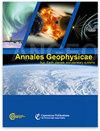“SafeSpace”超低功率谱密度和径向扩散系数数据库:依赖关系及其在模拟中的应用
IF 1.9
4区 地球科学
Q3 ASTRONOMY & ASTROPHYSICS
引用次数: 5
摘要
摘要径向扩散已被确定为外辐射带中相对论性电子的加速和损失以及向内辐射带提供粒子的最重要机制之一。在“安全空间”项目的框架下,我们使用了9年(2011-2019)THEMIS A、D和esatsatellite的多点磁场和电场测量数据,创建了一个径向扩散系数(DLL)和超低频(ULF)波功率谱密度(psd)数据库,其L∗范围为3到8。在这项工作中,我们研究了在太阳活动周期24期间,DLL对各种太阳风参数、地磁指数和耦合函数以及el -壳层的依赖。此外,我们还讨论了现场测量提供的部分方位覆盖对DLL时间序列估计所带来的不确定性。此外,我们通过叠加分析研究了DLL对太阳风驱动因素的依赖性。据我们所知,我们首次表明,行星际日冕物质抛射(ICME)驱动的扰动伴随着高太阳风压值和强烈的磁层压缩,可以产生与DLLE相当甚至更大的DLLB值。这个特性不能被半经验模型捕获,并且引入了对DLL的重大能量依赖。最后,我们通过Salammbô代码对相对论电子通量进行数值模拟,展示了使用DLLtime序列的优势,以及几种半经验模型根据地磁活动水平和l -壳层的预测存在显著偏差。本文章由计算机程序翻译,如有差异,请以英文原文为准。
The “SafeSpace” database of ULF power spectral density and radial diffusion coefficients: dependencies and application to simulations
Abstract. Radial diffusion has been established as one of the most important
mechanisms contributing to both the acceleration and loss of
relativistic electrons in the outer radiation belt, as well as to the
supply of particles to the inner radiation belt. In the framework of
the “SafeSpace” project, we have used 9 years (2011–2019) of multi-point
magnetic and electric field measurements from THEMIS A, D and E
satellites to create a database of radial diffusion coefficients
(DLL) and ultra-low-frequency (ULF) wave power spectral densities
(PSDs) spanning an L∗ range from 3 to 8. In this work we
investigate the dependence of the DLL on the various solar wind
parameters, geomagnetic indices and coupling functions, as well as the
L-shell, during the solar cycle 24. Moreover, we discuss the
uncertainties introduced on the estimation of DLL time series by
the partial azimuthal coverage provided by in situ
measurements. Furthermore, we investigate, via a superposed analysis,
the dependence of the DLL on solar wind drivers. We show, for the
first time to the best of our knowledge, that the interplanetary coronal mass
ejection (ICME)-driven disturbances accompanied by high solar wind
pressure values combined with intense magnetospheric compression can
produce DLLB values comparable to or even greater than the
ones of DLLE. This feature cannot be captured by
semi-empirical models and introduces a significant energy dependence
on the DLL. Finally, we show the advantages of using DLL
time series by means of numerical simulations of relativistic electron
fluxes performed with the Salammbô code and significant deviations in the predictions of several semi-empirical models depending on the level of geomagnetic activity and L-shell.
求助全文
通过发布文献求助,成功后即可免费获取论文全文。
去求助
来源期刊

Annales Geophysicae
地学-地球科学综合
CiteScore
4.30
自引率
0.00%
发文量
42
审稿时长
2 months
期刊介绍:
Annales Geophysicae (ANGEO) is a not-for-profit international multi- and inter-disciplinary scientific open-access journal in the field of solar–terrestrial and planetary sciences. ANGEO publishes original articles and short communications (letters) on research of the Sun–Earth system, including the science of space weather, solar–terrestrial plasma physics, the Earth''s ionosphere and atmosphere, the magnetosphere, and the study of planets and planetary systems, the interaction between the different spheres of a planet, and the interaction across the planetary system. Topics range from space weathering, planetary magnetic field, and planetary interior and surface dynamics to the formation and evolution of planetary systems.
 求助内容:
求助内容: 应助结果提醒方式:
应助结果提醒方式:


